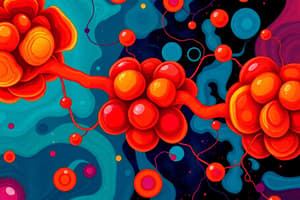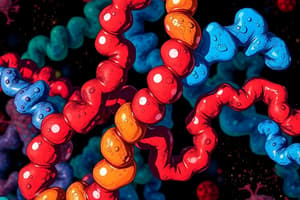Podcast
Questions and Answers
What effect does increased levels of 2,3-BPG have on the hemoglobin oxygen binding curve?
What effect does increased levels of 2,3-BPG have on the hemoglobin oxygen binding curve?
- It causes hemoglobin to bind oxygen irreversibly.
- It remains unchanged, no effect on affinity.
- It shifts to the right, decreasing hemoglobin's affinity for oxygen. (correct)
- It shifts to the left, increasing hemoglobin's affinity for oxygen.
In which state is hemoglobin locked when 2,3-BPG binds to it?
In which state is hemoglobin locked when 2,3-BPG binds to it?
- Tense state (correct)
- Relaxed state
- Oxygenated state
- Deoxygenated state
What by-product of glycolysis is implicated in the change of hemoglobin's oxygen affinity?
What by-product of glycolysis is implicated in the change of hemoglobin's oxygen affinity?
- Lactic acid
- Acetyl-CoA
- Pyruvate
- 2,3-BPG (correct)
What leads to the production of higher levels of 2,3-BPG in muscle cells?
What leads to the production of higher levels of 2,3-BPG in muscle cells?
What is the main role of carbon dioxide in the context of hemoglobin and tissue metabolism?
What is the main role of carbon dioxide in the context of hemoglobin and tissue metabolism?
How does the production of acid in exercising muscles affect hemoglobin's behavior?
How does the production of acid in exercising muscles affect hemoglobin's behavior?
Which cellular activity is most closely linked to a rise in 2,3-BPG levels?
Which cellular activity is most closely linked to a rise in 2,3-BPG levels?
What is the physiological significance of hemoglobin's shift to the right in the oxygen binding curve during high metabolic activity?
What is the physiological significance of hemoglobin's shift to the right in the oxygen binding curve during high metabolic activity?
What is the primary characteristic of myoglobin in relation to oxygen compared to hemoglobin?
What is the primary characteristic of myoglobin in relation to oxygen compared to hemoglobin?
What effect does a decrease in pH have on hemoglobin's binding of oxygen?
What effect does a decrease in pH have on hemoglobin's binding of oxygen?
What is the primary reason that hemoglobin can transport a total of four oxygen molecules?
What is the primary reason that hemoglobin can transport a total of four oxygen molecules?
Which statement correctly describes the influence of carbon dioxide on hemoglobin?
Which statement correctly describes the influence of carbon dioxide on hemoglobin?
Which physiological condition can increase the demand for oxygen rapidly?
Which physiological condition can increase the demand for oxygen rapidly?
How does 2,3-bisphosphoglycerate (2,3 BPG) affect hemoglobin's oxygen binding?
How does 2,3-bisphosphoglycerate (2,3 BPG) affect hemoglobin's oxygen binding?
What effect does the binding of the first oxygen molecule have on hemoglobin?
What effect does the binding of the first oxygen molecule have on hemoglobin?
In rapidly metabolizing tissues, what is a common effect on hemoglobin?
In rapidly metabolizing tissues, what is a common effect on hemoglobin?
What does the term 'Bohr Effect' refer to in hemoglobin function?
What does the term 'Bohr Effect' refer to in hemoglobin function?
Which statement accurately describes hemoglobin's behavior in oxygen delivery?
Which statement accurately describes hemoglobin's behavior in oxygen delivery?
Which of the following correctly describes the composition of hemoglobin?
Which of the following correctly describes the composition of hemoglobin?
What is the relation between rapidly metabolizing tissues and oxygen saturation of hemoglobin?
What is the relation between rapidly metabolizing tissues and oxygen saturation of hemoglobin?
Why is it favorable for hemoglobin to release oxygen in actively metabolizing tissues?
Why is it favorable for hemoglobin to release oxygen in actively metabolizing tissues?
How much more efficient is aerobic respiration compared to anaerobic respiration regarding ATP production?
How much more efficient is aerobic respiration compared to anaerobic respiration regarding ATP production?
What role does 2,3 BPG play in hemoglobin's oxygen binding capacity?
What role does 2,3 BPG play in hemoglobin's oxygen binding capacity?
Why is the presence of ferrous iron crucial for the function of hemoglobin?
Why is the presence of ferrous iron crucial for the function of hemoglobin?
What is the primary function of myoglobin in muscle cells?
What is the primary function of myoglobin in muscle cells?
Which state of hemoglobin is characterized by less flexibility and lower affinity for oxygen?
Which state of hemoglobin is characterized by less flexibility and lower affinity for oxygen?
What happens to hemoglobin's affinity for oxygen in more acidic conditions?
What happens to hemoglobin's affinity for oxygen in more acidic conditions?
What structural change occurs in hemoglobin when the first oxygen molecule binds?
What structural change occurs in hemoglobin when the first oxygen molecule binds?
What is the effect of the Bohr effect on oxygen delivery?
What is the effect of the Bohr effect on oxygen delivery?
Which curve illustrates the binding affinity of myoglobin for oxygen?
Which curve illustrates the binding affinity of myoglobin for oxygen?
Why is ferrous iron (Fe2+) crucial for oxygen binding in hemoglobin?
Why is ferrous iron (Fe2+) crucial for oxygen binding in hemoglobin?
What characteristic of hemoglobin's oxygen-binding behavior is indicated by its sigmoidal curve?
What characteristic of hemoglobin's oxygen-binding behavior is indicated by its sigmoidal curve?
What effect does the high level of 2,3 BPG in smokers have on hemoglobin's ability to transport oxygen?
What effect does the high level of 2,3 BPG in smokers have on hemoglobin's ability to transport oxygen?
Why is carbon monoxide exposure particularly dangerous for smokers?
Why is carbon monoxide exposure particularly dangerous for smokers?
What is the primary structural form of fetal hemoglobin?
What is the primary structural form of fetal hemoglobin?
How does fetal hemoglobin differ from adult hemoglobin in terms of 2,3 BPG binding?
How does fetal hemoglobin differ from adult hemoglobin in terms of 2,3 BPG binding?
What happens to hemoglobin in smokers as it passes through the lungs?
What happens to hemoglobin in smokers as it passes through the lungs?
What is the role of the additional histidine present at the heme iron site?
What is the role of the additional histidine present at the heme iron site?
What is a primary consequence of carbon monoxide exposure from smoking?
What is a primary consequence of carbon monoxide exposure from smoking?
What is the impact of CO2 and protons on hemoglobin binding?
What is the impact of CO2 and protons on hemoglobin binding?
Study Notes
Introduction to Hemoglobin and Myoglobin
- Animals require varying levels of oxygen depending on activity, with quick adjustments possible.
- Basal oxygen needs are substantial; diffusion alone is inadequate for delivery.
- Increased demands occur during exercise or stress, enhancing the need for oxygen.
Hemoglobin vs Myoglobin
-
Hemoglobin:
- A tetramer composed of two alpha and two beta subunits, can transport four oxygen molecules.
- Contains heme groups with ferrous iron (Fe2+), essential for oxygen binding.
- Exhibits cooperativity; initial O2 binding enhances subsequent bindings.
-
Myoglobin:
- A monomer that binds a single oxygen molecule, primarily for oxygen storage in muscle tissues.
- High binding affinity even at low oxygen levels, but releases oxygen under low concentrations.
Cooperativity
- Hemoglobin can exist in two states:
- Tense (T) state: Lower oxygen-binding flexibility.
- Relaxed (R) state: Facilitates easier oxygen binding and release.
- Conformational change occurs upon oxygen binding, enhancing the ability of remaining subunits to bind oxygen.
Bohr Effect
- pH influences oxygen release; lower pH (higher acidity) decreases hemoglobin's affinity for oxygen.
- Rapid metabolism in tissues produces protons and CO2, facilitating oxygen unloading to meet higher metabolic needs.
Role of 2,3 BPG
- 2,3-Bisphosphoglycerate (2,3 BPG) is a by-product of glycolysis, promoting oxygen release.
- Binds in a central cavity of hemoglobin, stabilizing the T state resulting in decreased oxygen affinity.
- Levels of 2,3 BPG increase during exercise, enhancing oxygen delivery to actively metabolizing tissues.
Interaction with Carbon Dioxide
- CO2 also facilitates oxygen release from hemoglobin by binding to sites other than the heme group.
- Bicarbonate formation in blood plays a critical role in CO2 transport, influencing the oxygen-binding dynamics.
Impacts of Smoking
- Smokers exhibit elevated levels of 2,3 BPG, locking hemoglobin in the T state, reducing oxygen transport efficacy.
- Carbon monoxide in smoke competes with oxygen for binding to heme groups, decreasing oxygen-carrying capacity, leading to health risks.
Fetal Hemoglobin
- Composed of α2γ2, fetal hemoglobin has a higher affinity for oxygen compared to adult hemoglobin.
- Does not bind 2,3 BPG effectively, predominantly remaining in the R-state, facilitating oxygen transfer from maternal to fetal blood.
Sickle Cell Anemia
- A genetic disease characterized by abnormal hemoglobin structure, leading to distorted red blood cell shapes and impaired oxygen transport.
Carbon Monoxide and Heme Interaction
- Carbon monoxide can bind to heme, competing with oxygen, leading to toxicity.
- An additional histidine in the heme site reduces but does not completely inhibit CO affinity.
Movement of CO2
- CO2 transport mechanisms are crucial for the respiratory cycle, impacting acid-base balance and oxygen delivery efficiency.
Studying That Suits You
Use AI to generate personalized quizzes and flashcards to suit your learning preferences.
Description
Explore the intricate relationship between hemoglobin and myoglobin in this quiz. Dive into their structures, functions, and key concepts such as cooperativity and the Bohr effect. Perfect for students wanting to deepen their understanding of these essential proteins.




